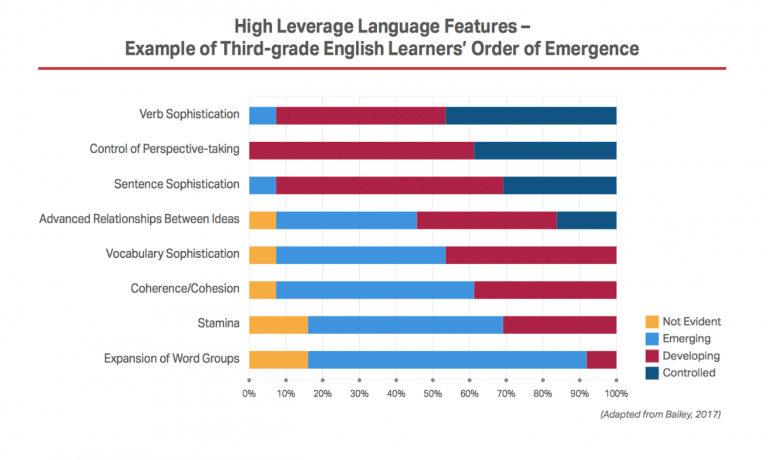UCLA Project Exc-EL Schools Design Learning Progressions for English Language Learners in Connecticut and New York
CompetencyWorks Blog

This post originally appeared at iNACOL on February 5, 2018. It is the eighth blog in a series that explores the ideas in the iNACOL report, Next Generation Learning Model for English Language Learners: Promising Practices and Considerations for Teaching and Learning. Read the first post here.
The following case study represents promising practices in the field using personalized, competency- based learning specifically for ELL students. Each case study in this blog series is considered promising in that they incorporate many of the core principles for next generation learning to support ELL student success. All case studies are examples of programs taking a longer view and a more holistic approach to student outcomes over time – defining the goal as helping students to achieve at high levels over the course of their schooling – in addition to becoming English-proficient.
Each case study addresses the core principles for next generation learning for ELL students that were discussed in previous blog posts:
- Redefining success for ELL students
- Assessments of and for learning
- Personalized learning approaches
- Building educator role and capacity
UCLA Project Exc-EL Schools
Location: Ossining High School, Ossining, NY
Grades Served: Middle and High School
In 2015, Project Exc-EL was created by English language researchers and educators at UCLA Center X to provide instructional supports to ELL educators. They have two projects that focus on using Dynamic Language Learning Progressions (DLLP) to assist educators in meeting ELL students where they are in their language and content learning. Project Exc-EL schools are characterized by (1) the use of student data to drive instruction, (2) the focus on personalized structures and supports, and (3) the inclusion of community partners.
Ossining High School in New York is one of the Project Exc-EL schools that is implementing its work on dynamic language learning progressions. Ossining enrolls 1,468 students, 51% of whom are economically disadvantaged with 140 students classified as ELLs. The school provides culturally responsive pathways for its emerging bilingual students. In the co-teaching model, an ELL teacher and a content area teacher co-plan, co-teach and co-assess students as they fully participate in classes with native English speakers. DLLP is used by language and content educators to plan, assess and determine where ELL students are in their learning. Additionally, the school provides accelerated instruction that integrates literacy and content learning for students with low literacy skills or interrupted formal education.
Redefining success for ELL students: The work of Project Exc-EL schools for ELL students began with examining the role of standards in schools. Researchers at UCLA wanted to know what kind of language expectations ELL students should meet in order to learn, for example, a math standard. The researchers developed DLLP to first help educators develop the strategies to unpack the skills and assumptions being asked by standards, and second, to provide a tool that can accurately gauge the language and content knowledge and development for ELL students.
DLLP was created after considering student needs in vocabulary, sentence and development phases and different types of language domains. There are seven feature areas that teachers can focus on to determine a “best fit” in terms of students’ current skill, knowledge and competency in that content as it relates to their language. Rubrics based on DLLP performance descriptions assess proficiency in four different categories: “Not Evident,” “Emerging,” “Developing” and “Controlled,” distinguishing between what ELL students can currently demonstrate via verbal and written explanations in their language development and what they need to do next to grow.
The High-leverage language features identify eight key characteristics, or key features related to words, sentences and discourse. Among these features are: verb sophistication, control of perspective-taking, sentence sophistication, advanced relationships between ideas, vocabulary sophistication, coherence/cohesion, stamina and expansion of word groups.
Assessment of and for learning: The DLLP process requires ongoing formative assessments and using data gathered to inform student learning and next steps. Project Exc-EL schools focus on student self-assessment and uses student-led conferences in student portfolios. The researchers worked to provide examples of what level student work should look like for oral and written work. Currently, there is a professional development and training lab based in California that focuses on developing teacher professional judgment on calibration and instruction using DLLP.
Personalized learning approaches: DLLPs provide educators with information on where ELL students are on their four language learning domains, as well as their academic content learning. Educators are trained to respond to student responses and plan lessons and assessments based on each student’s unique language learning progression. Personalizing learning through use of instructional strategies to meet students where they are is central to the work of DLLP.
Educator role and capacity: Educators use DLLP and content configurations to determine students’ levels in current language and content. Teachers use clearly calibrated rubrics and exemplars of student work to determine “best fit” of a student’s language development and content level. This helps educators determine where students are in their learning, map next steps in response to students’ learning progression, and target supports and services to individual student learning needs.
Teachers must analyze data on where student learning is to drive interventions and provide differentiated instructional strategies and learning tools and materials to provide ELL students with the opportunities they need to advance toward the next learning goal. This practice requires a growth mindset on behalf of educators to build on their craft to personalize instruction for ELL students.
Project Exc-EL focuses on developing their educator’s capacity to understand where students are in their learning development to scaffold instruction to best fit the needs of each learner. Content and ELL educators are encouraged to focus on holistic measurements of student performance based on multiple pieces of evidence. Using DLLP to guide student work, student answers and responses are not tied to a specific prompt from a teacher or dependent on familiarity on specific learning objectives. Teachers learn to scaffold with an understanding of where students should be on their language and content learning continuum based on written work, explanations and verbal expressions. Student explanations and work product provides the teacher with a selection of learning progressions that the student could take, depending on which answer they give. Further, teachers must analyze data on where student learning is to drive interventions and provide differentiated instructional strategies and learning tools and materials to provide ELL students with the opportunities they need to advance toward the next learning goal. This practice requires a growth mindset on behalf of educators to build on their craft to personalize instruction for ELL students.
Project Exc-EL’s DLLP began through the effort of educators to explore the multiple ways ELL students learn across academic content, language acquisition and literacy. The work of DLLP really supports educators in personalizing learning for ELL students by creating a method for educators to determine where ELL students are in their language and content learning.
Read the Entire Series:
- Post 1 – Next Generation Learning Models for English Language Learners
- Post 2 – Moving from Current Models of Teaching English Language Learners to New Learning Models Designed to Meet the Needs of All Students
- Post 3 – Promising Practices for Teaching English Language Learners
- Post 4 – The Promise of Next Generation Learning Models for English Language Learners
- Post 5 – Personalized, Competency-Based Education for English Language Learners
- Post 6 – International High School in Langley Park Creates a Learner-Driven System for English Language Learners in Maryland
- Post 7 – Case Study: Distinctive Schools Leads Personalized Learning for English Language Learners in Illinois and Minnesota
